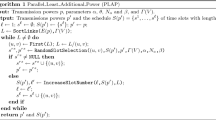Abstract
This work considers a multi-hop sensor network and addresses the problem of minimizing power consumption in each sensor node locally while ensuring two global (i.e., network wide) properties: (i) communication connectivity, and (ii) sensing coverage. A sensor node saves energy by suspending its sensing and communication activities according to a Markovian stochastic process. We show that a power level to induce a coverage radius \(\frac{w(n)}{n}\) is sufficient for connectivity provided that w(n)→∞. The paper presents a Markov model and its solution for steady state distributions to determine the operation of a single node. Given the steady state probabilities, we construct a non-linear optimization problem to minimize the power consumption. Simulation studies to examine the collective behavior of large number of sensor nodes produce results that are predicted by the analytical model.
Similar content being viewed by others
Explore related subjects
Discover the latest articles and news from researchers in related subjects, suggested using machine learning.References
I. F. Akyildiz, W. Su, Y. Sankarasubramaniam, and E. Cayirci, Wireless sensor networks: A survey, Computer Networks 38(4) (2002) 393–422.
B. Krishnamachari, D. Estrin, and S. Wicker, Impact of data aggregation in wireless sensor networks, in: Proc. Int. Workshop on DIstributed Event-Based Systems (Vienna, Austria, July 2002).
L. Lamport, Time, clocks, and the ordering of events in a distributed system, Communications of the ACM 21(7) (1978) 558–565.
N. Lynch, Distributed Algorithms (Morgan Kaufmann, San Mateo CA, 1996).
S. Singh and C. S. Raghavendra, Power efficient mac protocol for multihop radio networks, in: Proc. Nineth IEEE ISPIMRC’98 (1998) pp. 153–157.
Y. Xu, J. Heidemann, and D. Estrin, Geography-informed energy conservation for ad hoc networks, in: Proceedings MOBICOM’01, 2001 (2001).
B. Chen, K. Jamieson, H. Balakrishnan, and R. Morris, Span: An energy-efficient coordination algorithm for topology maintenance in ad hoc wireless networks, in Proc. Proceedings of MOBICOM’01 (2001).
A. Cerpa and D. Estrin, Ascent: Adaptive self-configuring sensor network topologies, in: Proceedings of INFOCOM’02 (2002).
M. Stemm and R. H. Katz, Measuring and reducing energy consumption of network interfaces in hand-held devices, IEICE Transactions on Communications E80-B(8) (August 1997) 1125–1131.
Y. Xu, J. Heidemann, and D. Estrin, Adaptive energy-conserving routing for multihop ad hoc networks, Tech. Rep. 527, USC/ISI, Los Angeles, CA (October 12 2000). http://www.isi.edu/johnh/PAPERS/Xu00a.pdf.
J. P. Monks, V. Bhargavan, and W. M. Hwu, A power controlled multiple access protocol for wireless packet networks, in: Proceedings of INFOCOM’01 (2001).
Y. Wei, J. Heidemann, and D. Estrin, An energy-efficient mac protocol for wireless sensor networks, in: Proceedings INFOCOM 2002 3 (2002) pp. 1567–1576.
P. Gupta and P. R. Kumar, Critical power for asymptotic connectivity in wireless networks, in: Stochastic Analysis, Control, Optimization and Applications, A Volume in Honor of W.H. Fleming. Edited by W.M. McEneany, G. Yin, and Q. Zhang (Birkhauser) (1998), pp. 547–566,
R. Ramanathan and R. Rosales-Hain, Topology control of multihop wireless networks using transmit power adjustments, in: Proc. IEEE INFOCOM’00 (2000).
T. A. ElBatt, S. V. Krishnamurthyand D. Connors, and S. Dao, Power management for throughput enhancement in wireless ad hoc networks, in: Proc. IEEE ICC’00 (2000).
S. Narayanaswamy, V. Kawadia, R.S. Sreenivas, and P. R. Kumar, Power control in ad-hoc networks: Theory, architecture, algorithm and implementation of the compow protocol, in: Proc. European Wireless Conference (2002).
S. Meguerdichian, F. Koushanfar, M. Potkonjak, and M. Srivastava, Coverage problems in wireless ad-hoc sensor networks, in: Proceedings of IEEE INFOCOM’01 (2001).
S. Shakkottai, R. Srikant, and N. Shroff, Unreliable sensor grids: Coverage, connectivity and diameter, in: Proceedings of IEEE INFOCOM’03 (2003).
Béla Bollobás, Random Graphs, Second Edition (Cambridge University Press, New York edition, 2001).
P. Hall, Introduction to the Theory of Coverage Processes (John Wiley & Sons, New York, 1988).
R. Meester and R. Roy, Continuum Percolation (Cambridge University Press, Cambridge, UK, 1996).
Paul G. Hoel, Sifney C. Port, and Charles J. Stone, Introduction to Stochastic Processes (Copyright © 1972 by Houghton Mifflin Company, Reissued by Waveland Press Inc., 1987, 1987).
J. Franklin, Mathematical Methods of Economics (Springer Verlag, New York, 1980).
Rajeev Motwani and Prabhakar Raghavan, Randomized Algorithms (Cambridge University Press, Cambridge, UK, 2000).
MathWorks, Matlab: The language of technical computing, Available through http://www.mathworks.com/.
Author information
Authors and Affiliations
Corresponding author
Rights and permissions
About this article
Cite this article
Yener, B., Magdon-Ismail, M. & Sivrikaya, F. Joint problem of power optimal connectivity and coverage in wireless sensor networks. Wireless Netw 13, 537–550 (2007). https://doi.org/10.1007/s11276-006-5875-0
Published:
Issue Date:
DOI: https://doi.org/10.1007/s11276-006-5875-0




